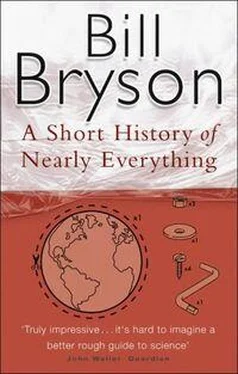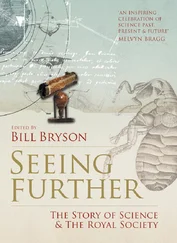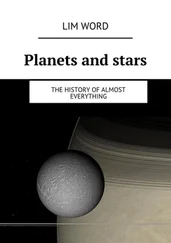A word on scientific notation: Since very large numbers are cumbersome to write and nearly impossible to read, scientists use a shorthand involving powers (or multiples) of ten in which, for instance, 10,000,000,000 is written 1010 and 6,500,000 becomes 6.5 x 106. The principle is based very simply on multiples of ten 10 x 10 (or 100) becomes 102: 10 x 10 x 10 (or 1,000) is 103; and so on, obviously and indefinitely. The little superscript number signifies the number of zeroes following the larger principal number. Negative notations provide essentially a mirror image, with the superscript number indicating the number of spaces to the right of the decimal point (so 10-4 means 0.0001). Though I salute the principle, it remains an amazement to me that anyone seeing “1.4 x 109 km3” would see at once that that signifies 1.4 billion cubic kilometers, and no less a wonder that they would choose the former over the latter in print (especially in a book designed for the general reader, where the example was found). On the assumption that many general readers are as unmathematical as I am, I will use them sparingly, though they are occasionally unavoidable, not least in a chapter dealing with things on a cosmic scale.
Properly called the Öpik-Oort cloud, it is named for the Estonian astronomer Ernst Öpik, who hypothesized its existence in 1932, and for the Dutch astronomer Jan Oort, who refined the calculations eighteen years later.
Triangulation, their chosen method, was a popular technique based on the geometric fact that if you know the length of one side of a triangle and the angles of two corners, you can work out all its other dimensions without leaving your chair. Suppose, by way of example, that you and I decided we wished to know how far it is to the Moon. Using triangulation, the first thing we must do is put some distance between us, so let’s say for argument that you stay in Paris and I go to Moscow and we both look at the Moon at the same time. Now if you imagine a line connecting the three principals of this exercise-that is, you and I and the Moon-it forms a triangle. Measure the length of the baseline between you and me and the angles of our two corners and the rest can be simply calculated. (Because the interior angles of a triangle always add up to 180 degrees, if you know the sum of two of the angles you can instantly calculate the third; and knowing the precise shape of a triangle and the length of one side tells you the lengths of the other sides.) This was in fact the method use by a Greek astronomer, Hipparchus of Nicaea, in 150 B.C. to work out the Moon’s distance from Earth. At ground level, the principles of triangulation are the same, except that the triangles don’t reach into space but rather are laid side to side on a map. In measuring a degree of meridian, the surveyors would create a sort of chain of triangles marching across the landscape.
How fast you are spinning depends on where you are. The speed of the Earth’s spin varies from a little over 1,000 miles an hour at the equator to zero at the poles.
The next transit will be on June 8, 2004, with a second in 2012. There were none in the twentieth century.
In 1781 Herschel became the first person in the modern era to discover a planet. He wanted to call it George, after the British monarch, but was overruled. Instead it became Uranus.
To a physicist, mass and weight are two quite different things. Your mass stays the same wherever you go, but your weight varies depending on how far you are from the center of some other massive object like a planet. Travel to the Moon and you will be much lighter but no less massive. On Earth, for all practical purposes, mass and weight are the same and so the terms can be treated as synonymous, at least outside the classroom.
There will be no testing here, but if you are ever required to memorize them you might wish to remember John Wilford’s helpful advice to think of the eras (Precambrian, Paleozoic, Mesozoic, and Cenozoic) as seasons in a year and the periods (Permian, Triassic, Jurassic, etc.) as the months.
Although virtually all books find a space for him, there is a striking variability in the details associated with Ussher. Some books say he made his pronouncement in 1650, others in 1654, still others in 1664. Many cite the date of Earth’s reputed beginning as October 26. At least one book of note spells his name “Usher.” The matter is interestingly surveyed in Stephen Jay Gould’s Eight Little Piggies.
Darwin loved an exact number. In a later work, he announced that the number of worms to be found in an average acre of English country soil was 53,767.
In particular he elaborated the Second Law of Thermodynamics. A discussion of these laws would be a book in itself, but I offer here this crisp summation by the chemist P. W. Atkins, just to provide a sense of them: “There are four Laws. The third of them, the Second Law, was recognized first; the first, the Zeroth Law, was formulated last; the First Law was second; the Third Law might not even be a law in the same sense as the others.” In briefest terms, the second law states that a little energy is always wasted. You can’t have a perpetual motion device because no matter how efficient, it will always lose energy and eventually run down. The first law says that you can’t create energy and the third that you can’t reduce temperatures to absolute zero; there will always be some residual warmth. As Dennis Overbye notes, the three principal laws are sometimes expressed jocularly as (1) you can’t win, (2) you can’t break even, and (3) you can’t get out of the game.
The notable exception being the Tyrannosaurus rex, which was found by Barnum Brown in 1902.
The confusion over the aluminum/aluminium spelling arose because of some uncharacteristic indecisiveness on Davy’s part. When he first isolated the element in 1808, he called it alumium. For some reason he thought better of that and changed it to aluminum four years later. Americans dutifully adopted the new term, but many British users disliked aluminum, pointing out that it disrupted the -ium pattern established by sodium, calcium, and strontium, so they added a vowel and syllable.
The principle led to the much later adoption of Avogadro’s number, a basic unit of measure in chemistry, which was named for Avogadro long after his death. It is ume of any other gas). Its value is placed at 6.0221367 x 1023, which is an enormously large number. Chemistry students have long amused themselves by computing just how large a number it is, so I can report that it is equivalent to the number of popcorn kernels needed to cover the United States to a depth of nine miles, or cupfuls of water in the Pacific Ocean, or soft drink cans that would, evenly stacked, cover the Earth to a depth of 200 miles. An equivalent number of American pennies would be enough to make every person on Earth a dollar trillionaire. It is a big number.
Specifically it is a measure of randomness or disorder in a system. Darrell Ebbing, in the textbook General Chemistry, very usefully suggests thinking of a deck of cards. A new pack fresh out of the box, arranged by suit and in sequence from ace to king, can be said to be in its ordered state. Shuffle the cards and you put them in a disordered state. Entropy is a way of measuring just how disordered that state is and of determining the likelihood of particular outcomes with further shuffles. Of course, if you wish to have any observations published in a respectable journal you will need also to understand additional concepts such as thermal nonuniformities, lattice distances, and stoichiometric relationships, but that’s the general idea.
Читать дальше












